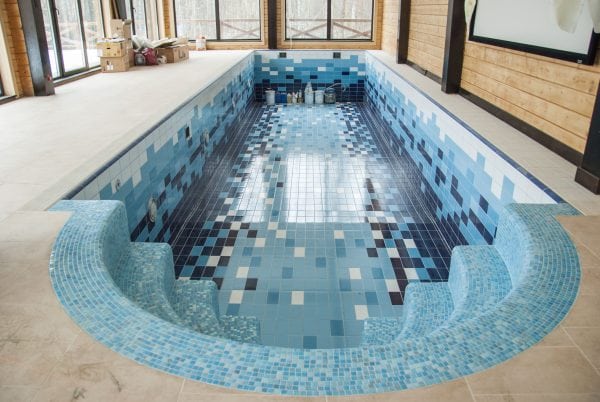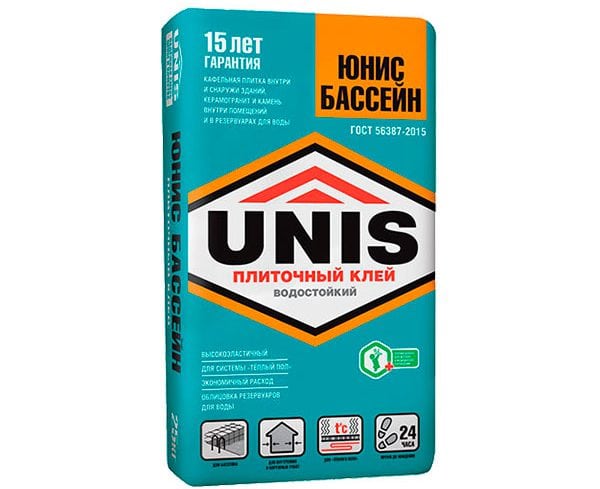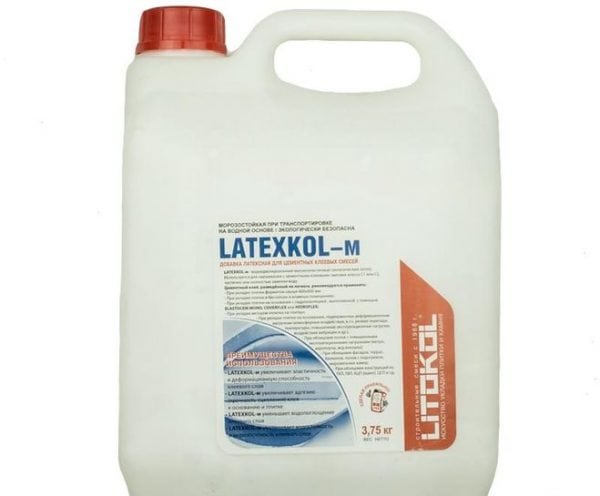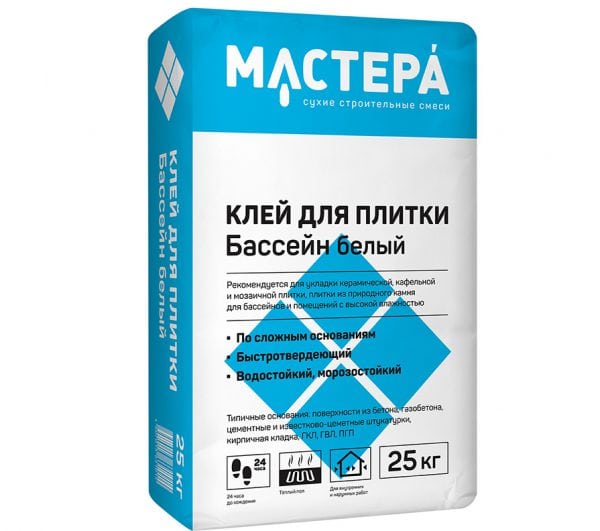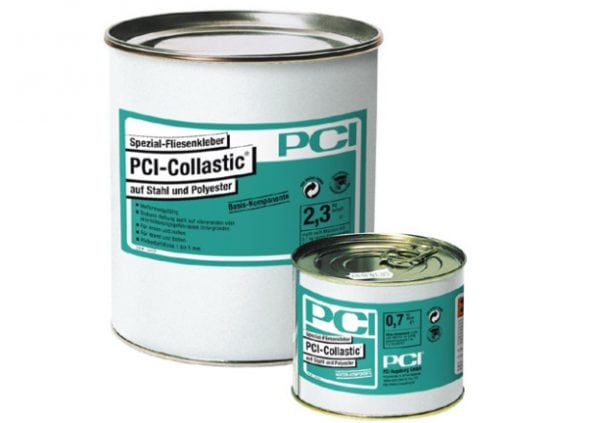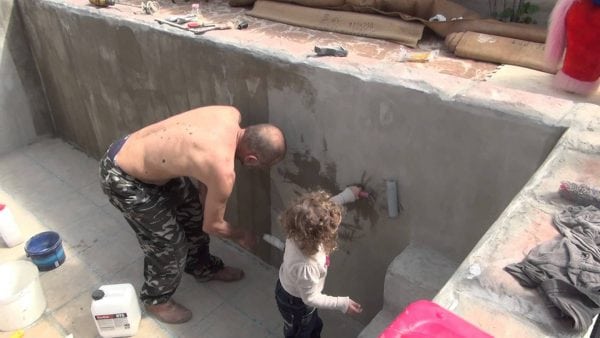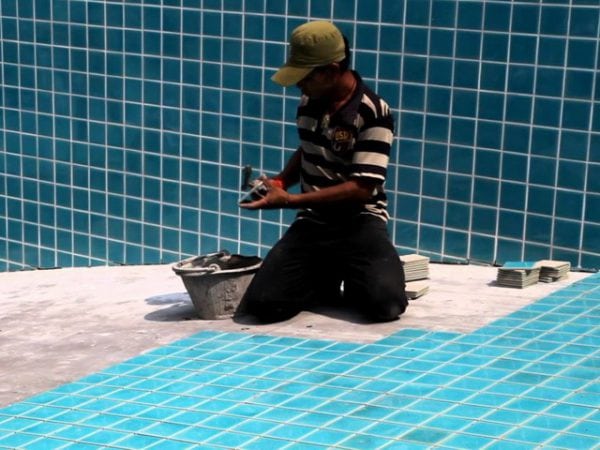As a material for lining pools is usually a special tile of a small size. It has a beautiful appearance and is very practical, durable. For gluing tiles and sealing joints, you need high-quality tile adhesive for swimming pools. It is this tool that increases the life of the tile and makes it resistant to mechanical damage.
- Pool Adhesive Requirements
- Glue selection
- Matching Pool Bowl
- Operating Mode Dependence
- Glue and water treatment systems
- Popular adhesives
- Instructions for use
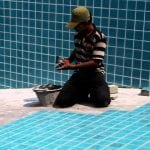
Pool Adhesive Requirements
How to choose the best material for laying the mosaic base, which will be subjected to high loads daily? You need to choose high-quality glue for work only if it fully meets a number of strict requirements. The product must meet the following characteristics:
- Resistance to water. Only waterproof glue provides complete waterproofing of the base, does not respond to prolonged contact with water. Also, the tool must be durable to easily withstand the pressure of a large volume of liquid.
- Inertness to the effects of chemistry. Chlorine, other disinfectants, household chemicals, and salts can destroy improper adhesives.
- Good adhesion. The glue should firmly hold the mosaic in the pool after curing.
- Elasticity. Only highly elastic compounds during deformation, internal and external impact will not crumble, they will not appear cracks, crevices.
- Lack of reaction to changes and temperature changes. High-quality glue is frost-resistant and heat-resistant, because the temperature of the water in the indoor pool fluctuates regularly, and in open buildings, ceramics freeze completely in winter. Also, the product must be resistant to changes in water temperature when it is heated or cooled.
- Antiseptic properties. The adhesive must necessarily contain special antifungal additives that will not allow molds to multiply.
- Security. The product is not suitable for the pool, if after drying it releases harmful substances into the water.
Thus, glue for pools is very different from the means for tiles in the bathroom. If the apartment has periodic contact with moisture, the floor and walls dry quickly, then water is constantly present in the pool bowl.
to contents ↑Moisture-resistant and able to seal the base adhesive - the most reliable in these operating conditions. This is due to the special components in the composition. Most often, adhesives on an epoxy or cement base are produced, but with an improved composition.
Glue selection
The range of tile adhesives is huge, but there are not so many of those that are ideal for swimming pools. Search should only be among reliable, proven brands. Which composition to choose? Typically, among waterproof adhesives there is a separation into dry mixes and ready-made solutions.The price per kilogram of the first is lower in terms of a square meter of the glued area of the pool. Dry mixes are sold in bags, sacks and are based on cement. Finished products are more often sold in buckets and banks, including epoxy or latex, acrylic, polyurethane.
General rules on fundraising are as follows:
- for rare use, in the absence of special requirements for aesthetics (for example, in the country), a dry cement mixture is suitable, it is inexpensive and holds the mosaic for a long time, firmly;
- for the implementation of design decisions, complex structures, it is worth investing in ready-made adhesive-sealant for gluing tiles.
Two-component latex agents, which have the highest adhesion rate, are considered the highest quality. Even large tiles can hold for a long time, do not come off when using this glue. So that he does not protrude from the grout, it is worth choosing a suitable color (mainly white). The package label must indicate: compliance with GOST, batch number, series, date and expiration date. Large manufacturers always reflect such information.
to contents ↑Matching Pool Bowl
When laying the mosaic of the bowl, it is necessary to compare the characteristics of the tile adhesive and the parameters of the tile - weight, type, size. The base material greatly affects the choice of adhesive composition by the degree of adhesion. Here are the recommended guidelines:
- for ceramics - 1 MPa;
- for glass mosaics - 2.5 MPa.
It is easy to lay tiles on a concrete, brick, stone bowl. These materials have a rough surface, so the lining will be fixed securely. Dry mixes will perfectly cope with the task, they can glue the pool bowl of any size. If you have to cover the base with glass mosaic, it is better to dilute the dry mixture not with water, but with an aqueous solution of latex. This will increase the strength parameters of the adhesive by an order of magnitude.
Ready mixes are acquired if the bowl is made of smooth materials (for example, low-pressure polyethylene). In this case, the tiling will perform only decorative functions, since the plastic itself is a good finishing material for the pool. A suitable option would be adhesive based on polyurethane, epoxy.
A great way to increase the performance of the glue is to add "water glass". This is a material based on potassium and sodium, which has a high penetrating ability. It can seal any type of substrate, therefore it is ideal for pool lining.
Glue "liquid glass" will give solidity, but only with strict observance of proportions. Having this unique product available, you don’t have to think about how to repair the crack in the pool. A mixture of cement glue and "liquid glass" will be the best solution for sealing damage.
to contents ↑Operating Mode Dependence
When the pool is used outdoors, frost resistance of the adhesive will become a must. Resistance to negative temperatures is important, as the tile along with the joints will regularly freeze in the winter. Despite draining the water in the fall, damage to conventional glue will become significant, it can quickly become cracked.
Frost resistance is due to the presence of additives that do not allow the material to expand after freezing. The constancy of the structure is distinguished, for example, by Ivsil Aqua glue. It is made on the basis of cement with the addition of polymeric substances. The product withstands the lowest temperatures, and the cladding retains its appearance for a long time.
to contents ↑Glue and water treatment systems
It is especially difficult to choose a quality composition for pools, which are visited by many people. They have to be cleaned often, regularly chlorinated.In this case, the quality of the composition as resistance to the action of disinfectants comes to the fore. Particularly aggressive are those that contain chlorine. The adhesive composition of Ardex X 77 has a so-called fiber-reinforced reinforcement (special additive), which allows it not to react to the action of chlorine and other chemicals.
to contents ↑Popular adhesives
Glue mosaic or tile in the pool can be domestic or imported compounds. The most popular adhesives are Ceresit. Here are the most famous:
- for ceramic tiles - Ceresit SM-16, SM-17 and SM-117, as well as the Eunice Pool;
- for marble, glass mosaics - IVSIL MOSAIK, Ceresit SM-115;
- for glazed clinker tiles - IVSIL AQUA, Ceresit SM-117;
- for porcelain stoneware - “Eunice Pool”, “Founder of Maxiplix T-16”.
Among the other brands of adhesives that are worth choosing are:
- "Farvest Pool C2TE25". Fine cement based sand and cement is suitable for fixing ceramics and any type of mosaic, natural and artificial stone. It is characterized by high frost resistance - up to 50 cycles, excellent ductility, water resistance. The glue is operated at temperatures from -50 to +60 degrees.
- “The TM-16 Pool will win.” A dry mixture of quartz sand and cement with the addition of special modifiers. If you have to stick a mosaic or tile on a flexible base made of plastic, instead of water in the mass you need to add "Solidolast ElastoTsem."
- PCI Nanolight. Highly elastic glue in the form of a dry mass, produced in two color options (there are white and gray compounds). Differs in absolute inertness to chemistry, salts, and also the highest water resistance.
- PCI Collastic. Polyurethane finished composition that does not require preliminary priming. Overlapping seams is allowed after 6 hours after gluing tiles. Due to the elasticity, the composition neutralizes the tension of the tile and protects the surface from deformation.
Work with these adhesives should be carried out at a temperature of + 5 ... + 30 degrees and humidity up to 75%.
to contents ↑Instructions for use
Even a novice can do the cladding of a small pool in the country, but it is better not to take on large areas with high requirements without proper experience. First you need to prepare the surface. The base must be dry, strong, have good bearing capacity. All crumbling parts, loose joints, stains of paint, oils, bitumen must be removed.
Level deviations should not be more than 1 mm per square meter of area. In order to improve adhesion to the surface, a treatment is carried out with a suitable primer in 2 layers. Strongly absorbent substrates (e.g. foam concrete) are primed several times.
Prepare the solution strictly according to the instructions. Only clean containers and tools are used. The dry mixture is poured in small portions into the water, but not vice versa - otherwise the mass will become stone. Changing the proportions yourself is prohibited!
Stir the glue for 3-5 minutes with a construction mixer, let it brew for 10 minutes. In the process, you need to regularly mix the solution so that it does not thicken. Dry adhesives are bred in small portions, because they have a short service life - up to 3-4 hours.
Adhesive consumption is 2-4 kg per square meter, if the layer thickness is about 1 mm. First, apply the product to the base, then lay a tile or mosaic according to the markup. The glue is immediately removed from the surface of the tile or glass, then it will be more difficult to do this. After 24 hours (for some adhesives - from 6 hours), you can begin to grout the seams.
You can use the pool only after 3-7 days, depending on the characteristics of the particular glue and grout. Before the first operation, the bowl must be disinfected. High-quality glue will guarantee a long service life of the pool, so you should not save on it.

